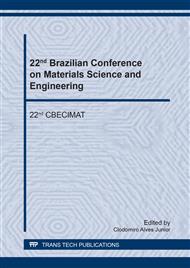p.541
p.546
p.552
p.556
p.562
p.568
p.572
p.578
p.584
Use of Retorted Shale as Sulfur Adsorbent
Abstract:
The aim of this work is to use a residue from shale gas production, known as retorted shale (RS), as an alternative material for processes of sulfur adsorptive desulfurization in liquid fuels such as gasoline or diesel. Therefore, retorted shale samples were chemically modified. Two methods were applied: acid leaching and impregnation. The first method (RS-HCl) was an acid treatment with HCl solution (3M) in proportion of 1.5: 10. The second method (RS-Fe) was a wet impregnation of 20%wt. of Fe followed by calcination at 700°C for 2 h. The adsorbents were characterized by X-ray diffraction (XRD) and scanning electron microscopy (SEM). The adsorption tests were performed using a solution of n-heptane and thiophene to simulate a fuel with an initial concentration of 500 ppm of sulfur. The results showed that both methods significantly altered the structure of the retorted shale, mainly the amount of Fe2O3. The adsorption test results indicated that the adsorbents prepared can remove up to 90% of the sulfur present.
Info:
Periodical:
Pages:
562-567
Citation:
Online since:
September 2018
Keywords:
Price:
Сopyright:
© 2018 Trans Tech Publications Ltd. All Rights Reserved
Share:
Citation:


